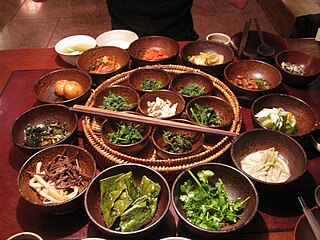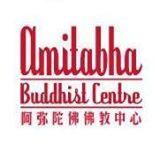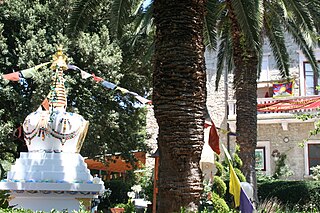Related Research Articles

Buddhist cuisine is an Asian cuisine that is followed by monks and many believers from areas historically influenced by Mahayana Buddhism. It is vegetarian or vegan, and it is based on the Dharmic concept of ahimsa (non-violence). Vegetarianism is common in other Dharmic faiths such as Hinduism, Jainism and Sikhism, as well as East Asian religions like Taoism. While monks and a minority of believers are vegetarian year-round, many believers follow the Buddhist vegetarian diet for celebrations.
Hīnayāna is a Sanskrit term literally meaning the "small/deficient vehicle". Classical Chinese and Tibetan teachers translate it as "smaller vehicle". The term is applied collectively to the Śrāvakayāna and Pratyekabuddhayāna paths.

The Kadam school of Tibetan Buddhism was an 11th century Buddhist tradition founded by the great Bengali master Atiśa (982-1054) and his students like Dromtön (1005–1064), a Tibetan Buddhist lay master. The Kadampa stressed compassion, pure discipline and study.
Vipassanā (Pāli) or විපස්සනා (Sinhala) literally "special, super (Vi), seeing (Passanā)", is a Buddhist term that is often translated as "insight". The Pali Canon describes it as one of two qualities of mind which is developed in bhāvanā, the training of the mind, the other being samatha. It is often defined as a practice that seeks "insight into the true nature of reality", defined as anicca "impermanence", dukkha "suffering, unsatisfactoriness", anattā "non-self", the three marks of existence in the Theravada tradition, and as śūnyatā "emptiness" and Buddha-nature in the Mahayana traditions.
Buddhism in the West broadly encompasses the knowledge and practice of Buddhism outside of Asia in the Western world. Occasional intersections between Western civilization and the Buddhist world have been occurring for thousands of years. The first Westerners to become Buddhists were Greeks who settled in Bactria and India during the Hellenistic period. They became influential figures during the reigns of the Indo-Greek kings, whose patronage of Buddhism led to the emergence of Greco-Buddhism and Greco-Buddhist art. There was little contact between the Western and Buddhist cultures during most of the Middle Ages but the early modern rise of global trade and mercantilism, improved navigation technology and the European colonization of Asian Buddhist countries led to increased knowledge of Buddhism among Westerners. This increased contact led to various responses from Buddhists and Westerners throughout the modern era. These include religious proselytism, religious polemics and debates, Buddhist modernism, Western convert Buddhists and the rise of Buddhist studies in Western academia. During the 20th century, there was a growth in Western Buddhism due to various factors such as immigration, globalization, the decline of Christianity and increased interest among Westerners. The various schools of Buddhism are now established in all major Western countries making up a small minority in the United States, Europe, Australia and New Zealand.

Geshe Kelsang Gyatso is a Buddhist monk, meditation teacher, scholar, and author. He is the founder and former spiritual director of the New Kadampa Tradition-International Kadampa Buddhist Union (NKT-IKBU), a registered non-profit, modern, sectarian and schismatic organization that came out of the Gelugpa school/lineage. 1,300 centres around the world, including temples, city temples and retreat centres offer an accessible approach to ancient wisdom.
The Dorje Shugden controversy is a controversy over Dorje Shugden, also known as Dolgyal, who some consider to be one of several protectors of the Gelug school, the school of Tibetan Buddhism to which the Dalai Lamas belong. Dorje Shugden has become the symbolic centre-point of a conflict over the "purity" of the Gelug school and the inclusion of non-Gelug teachings, especially Nyingma ones.
Thubten Kunga Ling Center (TKC), is a Buddhist Center in Deerfield Beach, Florida. TKC follows the Gelugpa tradition of Tibetan Buddhism, which is the lineage of the Dalai Lama. The center offers classes on meditation and Buddhist philosophy. The resident teacher is Venerable Lhundub Tendron.

The New Kadampa Tradition – International Kadampa Buddhist Union (NKT—IKBU) is a global Buddhist new religious movement founded by Kelsang Gyatso in England in 1991. In 2003 the words "International Kadampa Buddhist Union" (IKBU) were added to the original name "New Kadampa Tradition". The NKT-IKBU is an international organisation registered in England as a charitable, or non-profit, company. It currently lists more than 200 centres and around 900 branch classes/study groups in 40 countries.

The Foundation for the Preservation of the Mahayana Tradition (FPMT) was founded in 1975 by Lamas Thubten Yeshe and Thubten Zopa Rinpoche, who began teaching Mahayana Buddhism to Western students in Nepal. The FPMT has grown to encompass over 160 dharma centers, projects, and services in 37 countries. Since the death of Lama Yeshe in 1984, the FPMT's spiritual director has been Lama Zopa Rinpoche.

Sogyal Rinpoche was a Tibetan Dzogchen lama. He was recognized as the incarnation of a Tibetan master and visionary saint of the 19th century, Tertön Sogyal Lerab Lingpa. Sogyal Rinpoche was the founder and former spiritual director of Rigpa — an international network of over 100 Buddhist centres and groups in 23 countries around the world — and the author of the best-selling book The Tibetan Book of Living and Dying, which has been printed in 30 languages and 56 countries. Before his retirement, in the wake of abuse allegations in 2017, he had been teaching for 40 years in Europe, America, Asia and Australia.

Buddhist vegetarianism is the practice of vegetarianism by significant portions of Mahayana Buddhist monks and nuns and some Buddhists of other sects. In Buddhism, the views on vegetarianism vary between different schools of thought. The Mahayana schools generally recommend a vegetarian diet because Gautama Buddha set forth in some of the sutras that his followers must not eat the flesh of any sentient being.
Namgyal Rinpoche, Karma Tenzin Dorje (1931–2003), born Leslie George Dawson in Toronto, Canada, was a Tibetan Buddhist lama in the Karma Kagyu tradition.

Amitabha Buddhist Centre is a Buddhist institution in Geylang, Singapore. It is affiliated with the Foundation for the Preservation of the Mahayana Tradition (FPMT), an international non-profit organisation, founded by Lama Thubten Yeshe.
Buddhism in the United Kingdom has a small but growing number of adherents which, according to a Buddhist organisation, is mainly a result of conversion. In the UK census for 2011, there were about 247,743 people who registered their religion as Buddhism, and about 174,000 who cited religions other than Christianity, Buddhism, Hinduism, Judaism, Islam, Jainism and Sikhism. This latter figure is likely to include some people who follow the traditional Chinese folk religion which also includes some elements of Buddhism.
Thekchen Choling is a registered Buddhist organisation in the Republic of Singapore. The organisation was started in 2001 by Singha Thekchen Rinpoche and a group of his initial disciples. The organisation promotes non-sectarian Buddhism, emphasizing understanding of Theravada and Mahayana teachings.

The Istituto Lama Tzong Khapa (ILTK) in Pomaia, a village in Tuscany, in Italy is a branch of the Foundation for the Preservation of the Mahayana Tradition (FPMT), an international network of Gelugpa dharma centers. It is named for Tsongkhapa, founder of the Gelugpa monastic order of Tibetan Buddhism. The Dalai Lama has taught there on several occasions.
Manjushri Institute was a large Buddhist college situated at Conishead Priory in Cumbria, England from 1976 until its dissolution in 1991. In 1991 its assets, including Conishead Priory, were transferred to a new centre on the same premises, Manjushri Mahayana Buddhist Centre, which was later renamed Manjushri Kadampa Meditation Centre.

Buddhism in Scotland is a relatively recent phenomenon. In Scotland Buddhists represent 0.24% of the population or around 13,000 people.
Tharpa Publications is a New York-based "major international and multilingual publisher of Buddhist books" by the Buddhist author and scholar Geshe Kelsang Gyatso. These include basic Buddhist meditation books such as The New Meditation Handbook, books on the Buddhist way of life such as Universal Compassion, books on Buddhist philosophy and psychology such as Heart of Wisdom, and books on Buddhist Tantra. Tharpa Publications is a non-profit corporation that has operated for 25 years and claims to have sold over a million books. Waterhouse adds that the books "are distributed widely and may be seen on the shelves of popular booksellers as well as in university libraries."
References
- ↑ Khensur Lobsang Thubten Rinpoche. "A Perfect Human Rebirth". Mahayana Buddhist Association. Retrieved 18 November 2007.
- ↑ Lama Jigme Rinpoche (1 March 2003). "Living in a Dharma Center". Archived from the original on 10 October 2007. Retrieved 18 November 2007.
- ↑ "Kadampa Dharma Centers". The official site of the New Kadampa Tradition . Retrieved 18 November 2007.